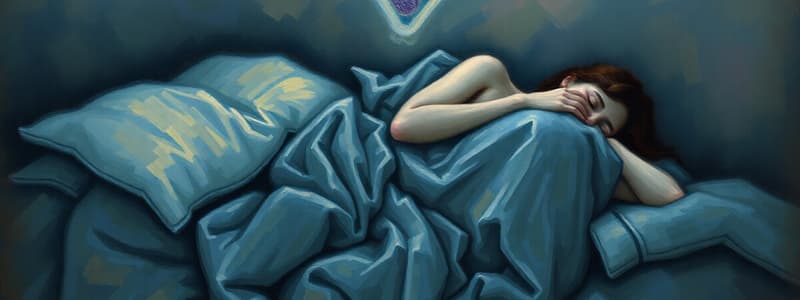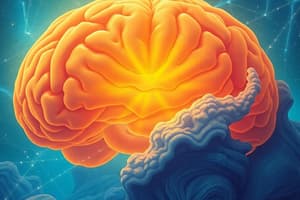Podcast
Questions and Answers
Which of the following best describes the primary aim of the Dement and Kleitman (1957) sleep study?
Which of the following best describes the primary aim of the Dement and Kleitman (1957) sleep study?
- To investigate the effects of sleep deprivation on cognitive performance.
- To examine the relationship between dream recall and sleep stages, eye movements, and dream content. (correct)
- To compare sleep patterns between different age groups.
- To determine the average length of a sleep cycle in humans.
In the Dement and Kleitman study, what physiological measure was used to define the different stages of sleep?
In the Dement and Kleitman study, what physiological measure was used to define the different stages of sleep?
- Electroencephalogram (EEG) (correct)
- Heart rate variability
- Body temperature
- Blood pressure
What was the main conclusion of the Dement and Kleitman study regarding the relationship between dream recall and REM sleep?
What was the main conclusion of the Dement and Kleitman study regarding the relationship between dream recall and REM sleep?
- Dream recall is equally likely in both REM and non-REM sleep.
- Dream recall is more frequent following REM sleep compared to non-REM sleep. (correct)
- Dream recall is less frequent following REM sleep compared to non-REM sleep.
- Dream recall only occurs during deep stages of non-REM sleep.
According to Dement and Kleitman's research, what is the typical length of a sleep cycle (from the beginning of stage 1 to the end of REM) in adults?
According to Dement and Kleitman's research, what is the typical length of a sleep cycle (from the beginning of stage 1 to the end of REM) in adults?
In the Dement and Kleitman study, how did the researchers investigate the relationship between the direction of eye movements during REM sleep and the content of dreams?
In the Dement and Kleitman study, how did the researchers investigate the relationship between the direction of eye movements during REM sleep and the content of dreams?
What methodological control was implemented in the Dement and Kleitman study to minimize the influence of experimenter bias when collecting dream reports?
What methodological control was implemented in the Dement and Kleitman study to minimize the influence of experimenter bias when collecting dream reports?
What general trend did Dement and Kleitman observe regarding the length of REM periods throughout the night?
What general trend did Dement and Kleitman observe regarding the length of REM periods throughout the night?
Considering the implications of the Dement and Kleitman study, what might be a consequence of consistently disrupting someone's REM sleep?
Considering the implications of the Dement and Kleitman study, what might be a consequence of consistently disrupting someone's REM sleep?
What is a key limitation of the Dement and Kleitman study that might affect the generalizability of the findings?
What is a key limitation of the Dement and Kleitman study that might affect the generalizability of the findings?
How did the Dement and Kleitman study contribute to further research in the field of sleep and dream science?
How did the Dement and Kleitman study contribute to further research in the field of sleep and dream science?
Flashcards
REM Sleep
REM Sleep
A period of sleep with rapid eye movements, dreaming, and muscle atonia.
EEG
EEG
Electroencephalogram; measures brain electrical activity using electrodes on the scalp.
EOG
EOG
Electrooculogram; measures eye movements using electrodes placed near the eyes.
Dream Report
Dream Report
Signup and view all the flashcards
Dement & Kleitman Aim
Dement & Kleitman Aim
Signup and view all the flashcards
REM-Dream Correlation
REM-Dream Correlation
Signup and view all the flashcards
Eye Movement & Dream Content
Eye Movement & Dream Content
Signup and view all the flashcards
Dream Duration & REM Length
Dream Duration & REM Length
Signup and view all the flashcards
Purpose of Study 1
Purpose of Study 1
Signup and view all the flashcards
Purpose of Study 2
Purpose of Study 2
Signup and view all the flashcards
Study Notes
- Dement and Kleitman's 1957 study investigated the relationship between eye movements and dreaming during sleep
Participants
- Nine adult participants were studied, but results from only seven were widely reported
- Some participants were identified by their initials (WD, KC, DN, IR, DE, PM, and BB)
Procedure
- Participants arrived at the lab before their normal bedtime and slept in a dark, quiet room
- EEG electrodes were attached to the participants' scalp and around the eyes to record brain activity and eye movements
- Participants were awakened at various times during the night and asked to report their dream content
EEG Measurement
- EEG was used to objectively measure brain activity and identify different sleep stages, particularly REM sleep
- EEG recordings helped determine when dreaming was most likely to occur
Eye Movement Measurement
- EOG (electro-oculogram) recorded horizontal and vertical eye movements during sleep
- Researchers observed correlations between eye movement patterns and the content of dreams
Aims
- To investigate the relationship between eye movements and dream content.
- To test whether dream recall differs between REM and NREM sleep stages
- To investigate whether the duration of REM sleep correlates with the duration of dreams
Hypotheses
- Hypothesis 1: There is a relationship between REM sleep and dreaming
- Hypothesis 2: There is a relationship between the type of eye movement and the image in the dream
- Hypothesis 3: There is a relationship between the duration of REM sleep and the participant's estimate of dream duration
Findings: Dream Recall
- Dreams were more frequently reported during REM sleep than during NREM sleep
- 79.6% of awakenings during REM sleep produced dream reports, compared to 7% during NREM
- Participants could often accurately recall the dream content when awakened during REM sleep
Findings: Eye Movements
- Patterns of eye movements during REM sleep were related to the visual content of dreams
- Vertical eye movements were associated with dreams involving vertical movements (e.g., climbing a ladder)
- Horizontal eye movements were associated with dreams involving horizontal movements (e.g., watching a tennis match)
- Little to no eye movement was associated with dreams involving fixed objects or distant vision
Findings: Dream Duration
- Participants were able to estimate the length of their dreams accurately
- The duration of REM sleep was significantly correlated with the participant's estimate of dream duration
- Participants who were awakened after 5 minutes of REM sleep estimated their dream duration to be shorter than those awakened after 15 minutes
Conclusions
- REM sleep is a distinct sleep stage associated with dreaming
- Eye movements during REM sleep are related to the content of dreams
- The duration of REM sleep correlates with the subjective duration of dreams
Methodological Considerations
- The study used a laboratory experiment, allowing for controlled observation of sleep patterns
- EEG and EOG provided objective measures of brain activity and eye movements
- The sample size was small, which limits the generalizability of the findings
- Participants had to sleep in an unusual environment, which might have affected their sleep patterns
Strengths
- Use of objective measures (EEG, EOG) increased the validity of the findings
- High level of control in the laboratory setting
- Findings provided valuable insights into the nature of dreaming and its relationship to sleep stages
Weaknesses
- Small sample size limits generalizability
- Artificial laboratory environment might have affected sleep patterns
- Reliance on self-report for dream content introduces potential bias
- Intrusive awakenings may have impacted dream recall
Studying That Suits You
Use AI to generate personalized quizzes and flashcards to suit your learning preferences.




